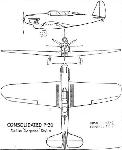
Consolidated Model 25, Model 26 и Model 27
"Detroit Aircraft Corporation", чьей дочерней компанией была "Lockheed Aircraft Company", отказалась от строительства самолетов в 1932 году. Один из конструкторов перешел в "Consolidated", где продолжил работу над созданием военного самолета на базе наработок по Lockheed Altair. Эта работа вызвала интерес Авиационного корпуса Армии США, в результате чего был заключен контракт на два прототипа. Один представлял собой двухместный истребитель Y1P-25 - заводское обозначение Model 25, второй был ударной модификацией того же самолета под обозначением Y1A-11 - заводское обозначение Model 27. Он отличался от истребителя наличием передних фиксированных 7,62-мм пулеметов и наружными подвесками для 181 кг бомб.
Y1P-25 имел свободнонесущее низкорасположенное крыло и цельнометаллическую конструкцию, за исключением полотняной обшивки рулевых поверхностей хвостового оперения. Шасси - колесное с хвостовым колесом и с убираемыми основными стойками. Силовая установка включала один V-образный двигатель с турбонаддувом Curtiss V-1570-27 Conqueror. Экипаж из двух пилотов располагался тандемно в закрытой кабине. Первый полет Y1P-25 состоялся в конце 1932 года, но 13 января 1933 года самолет разбился, хотя за этот короткий промежуток времени он успел продемонстрировать столь удовлетворительные летные качества, что Авиационный корпус заказал четыре в целом аналогичных самолета для эксплуатационных испытаний. Эти машины отличались установкой двигателя с турбонаддувом V-1710-5 7 Conqueror, упрощенным шасси и переделанным фонарем кабины. Летом 1934 года самолет прошел испытания под обозначением P-30 (фирменное обозначение Model 26), продемонстрировав удовлетворительные летные качества, после чего в декабре 1934 года был заключен контракт на 50 истребителей P-30A. Машины оснащались более мощным двигателем с турбонаддувом V-1710-61 и воздушным винтом изменяемого шага. Самолет, поступивший в эксплуатацию в 1935 году, стал единственным двухместным истребителем-монопланом, принятым на вооружение Авиационным корпусом Армии США в межвоенный период. Вскоре после поступления на вооружение P-30A поменял обозначение на PB-2A, а остальные экземпляры P-30 получили обозначение PB-2.
Развитие самолета Y1A-11 продолжалось параллельно с поставкой четырех A-11 для эксплуатационных испытаний. Они отличались от P-30 двигателем без турбонаддува и двухлопастным воздушным винтом, однако, несмотря на то, что один из самолетов был переоборудован в XA-11A с V-образным двигателем Allison XV-1710-7 мощностью 1000 л.с. (746 кВт), не было заказано ни одной серийной машины.
Самолеты YP-27 и YP-28 не были построены.
ТАКТИКО-ТЕХНИЧЕСКИЕ ХАРАКТЕРИСТИКИ
Consolidated Model 26 (PB-2A)
Тип: двухместный истребитель
Силовая установка: один V-образный ПД Curtiss V-1710-61 мощностью 700 л. с. (522 кВт)
Летные характеристики: макс. скорость 441 км/ч на высоте 7620 м; крейсерская скорость на оптимальной высоте 346 км/ч; набор высоты 4570 м-за 7 мин 47 с; практический потолок 8535 м; дальность 818 км
Масса: пустого 1953 кг; максимальная взлетная 2560 кг
Размеры: размах крыла 13,39 м; длина 9,14 м; высота 2,51; площадь крыла 27,58 м2
Вооружение: два фиксированных 7,62-мм пулемета Browning и один наводимый 7,62-мм пулемет Browning в задней части кабины
Описание:
- Consolidated Model 25, Model 26 и Model 27
- Flight, August 1934
AMERICAN MILITARY MONOPLANES - Flight, February 1935
FOR "PURSUIT" WORK - Flight, January 1936
SOME NEW AMERICANS
Фотографии
-
Flight 1934-08 / Flight
A TWO-SEATER PURSUIT TYPE: The Consolidated P-25 is being followed up by a later version, the P-30, with Curtiss "Conqueror" engine.
-
Flight 1934-12 / Flight
TWO-SEATER FIRE POWER - SINGLE-SEATER SPEED: The Consolidated P. 30 two-seater "pursuit" or fighter monoplane believed to be the type ordered by the U.S. Army Air Corps as stated on this page. Fitted with a twelve cylinder Curtiss "Conqueror" of 650 h.p., equipped with an exhaust-driven supercharger, the top speed is about 250 m.p.h. - faster than most single seaters.
-
Flight 1937-09 / Flight
Exhaust driven superchargers are incorporated on the glycol-cooled Curtiss Conqueror engines of the Consolidated two-seater pursuit monoplanes of the U.S. Army Air Corps.
-
Flight 1936-01 / Flight
The prototype Consolidated P-30 two-seater pursuit with Curtiss Conqueror engine. The type has been adopted by the U.S. Army Air Corps.
-
Jane's All the World Aircraft 1980 / Encyclopedia of Aviation - Aircraft A-Z - v2
Consolidated PB-2A modified into a single-seat fighter. Remained a prototype.
-
Мировая Авиация 92
Обратите внимание на расположение турбонаддува двигателя Curtiss самолета PB-2A - впереди и выше корневой части левой плоскости крыла.
-
Flight 1935-11 / Flight
Consolidated P-30 (U.S.A.).
-
Flight 1935-02 / Flight
Consolidated P-30 Curtiss "Conqueror" Engine
- Фотографии







